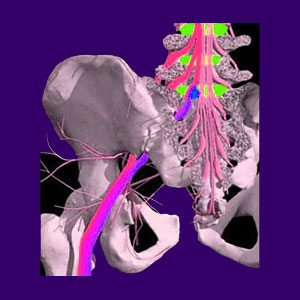
The ischiatic nerve, also called the sciatic nerve, is the largest single nerve in the body and is responsible for providing neurological functionality, including motor and sensory abilities, to almost the entire lower body region. The sciatic nerve is made up of spinal nerve roots from the L4, L5, S1, S2 and S3 levels, which all come together to create a peripheral network of primary and secondary nerves branching off the main sciatic structure. There is no single nerve structure implicated in more chronic pain syndromes than the sciatic. Patients may suffer various symptoms involving this super nerve, including pain, burning, tingling, numbness, weakness and others.
Causes for sciatica can be spinally-motivated, or may fall under the heading of pseudosciatica, which are all non-spinally enacted. One thing is for sure… All sciatica complaints have terrible reputations as being defiant to treatment and typically are ongoing conditions which plague patients for years. This article provides some lesser known facts about the great ischiatic tissue that innervates most of our lower body.
Ischiatic Nerve Anatomy
The sciatic nerve has a left and right branch. This bilateral setup provides individual nerve functionality to each side of the buttocks and each leg independently. Virtually all the sensory and motor abilities of the legs are controlled by the sciatic, although the genitals and some other areas are served by the lower sacral nerves directly.
The sciatic is the thickest nerve the body and is robust and structurally resilient, as nerves go. Branches of the sciatic nerve form a complicated network of large, medium, small and tiny nerves which provide neurological pathways to all the cellular structures of the legs and feet.
It should be noted that the sciatic nerve never attaches to the spine directly. It only connects via the 5 nerve roots named previously.
Sciatic Nerve Pain
Sciatica is the condition commonly diagnosed when a patient endures any of the following set of symptoms in the legs or feet: pain, tingling, numbness or weakness. These symptoms are often known as the four horsemen to lower back and leg pain sufferers who must deal with their own private apocalypse every time the condition flares up.
True sciatica describes a symptomatic expression due to a spinal causation, while pseudo-sciatica is the correct term for nerve pain which is not enacted in the spine, but rather through a muscular or ischemic issue.
It is crucial for patients to know that sciatica is always a symptom and should never be a diagnosis. If a physician or chiropractor diagnoses you with sciatica, ask them if they even understand what the condition is. Tell them: Sciatica is a symptom set, not a diagnosis.
Then ask them what is causing the sciatica and you will have your diagnosis.
Ischiatic Nerve Symptomology
Sciatica is one of the most common conditions treated in the dorsopathy industry. It may or may not exist in combination with actual back ache, although the majority of patients do endure considerable lower back pain, as well.
When sciatica symptoms appear, the diagnosis is almost always theorized immediately to involve foraminal stenosis around one or more of the nerve roots which create the sciatic structure. In some cases, this diagnosis is correct, especially when the symptoms include objective numbness and weakness in a well defined and corresponding anatomical region.
However, in many cases, the diagnosis is wrong, even when a herniated disc or osteophyte complex is encroaching on the neuroforaminal space, since chronic pain also exists. Remember that lasting pain is not typically an actual symptom of a pinched nerve.




